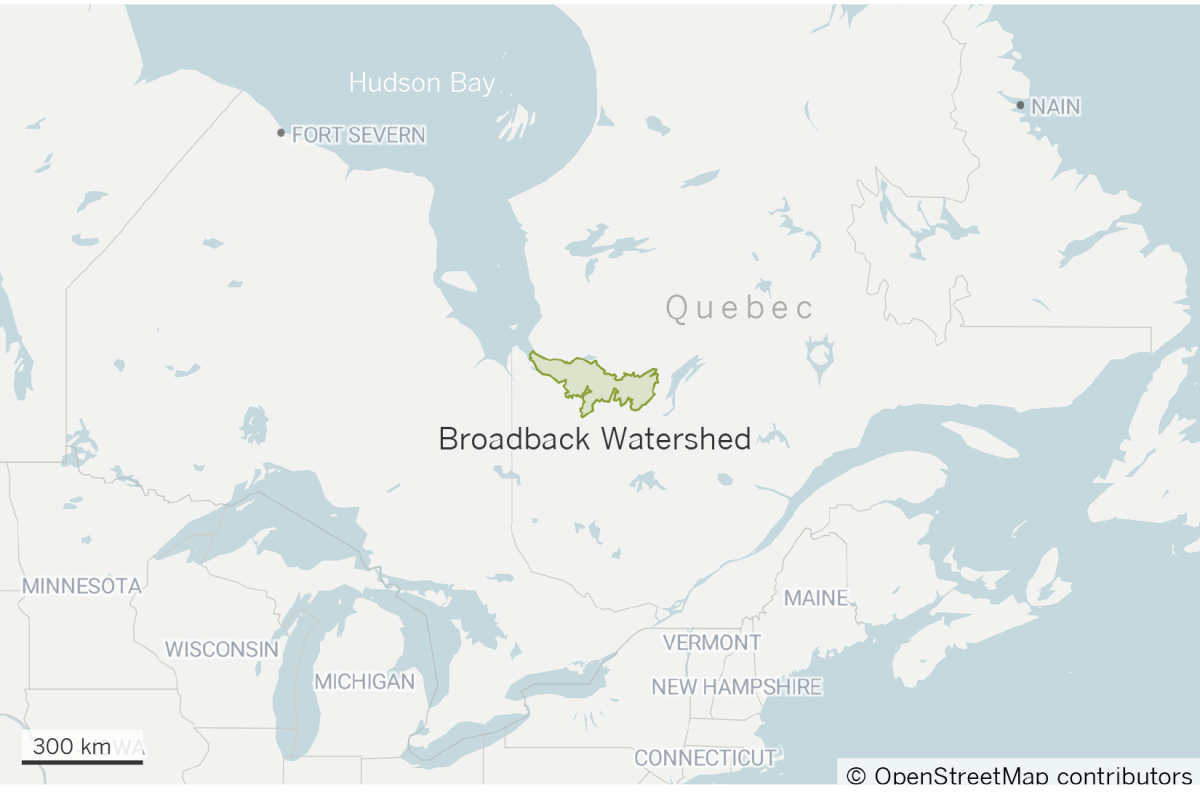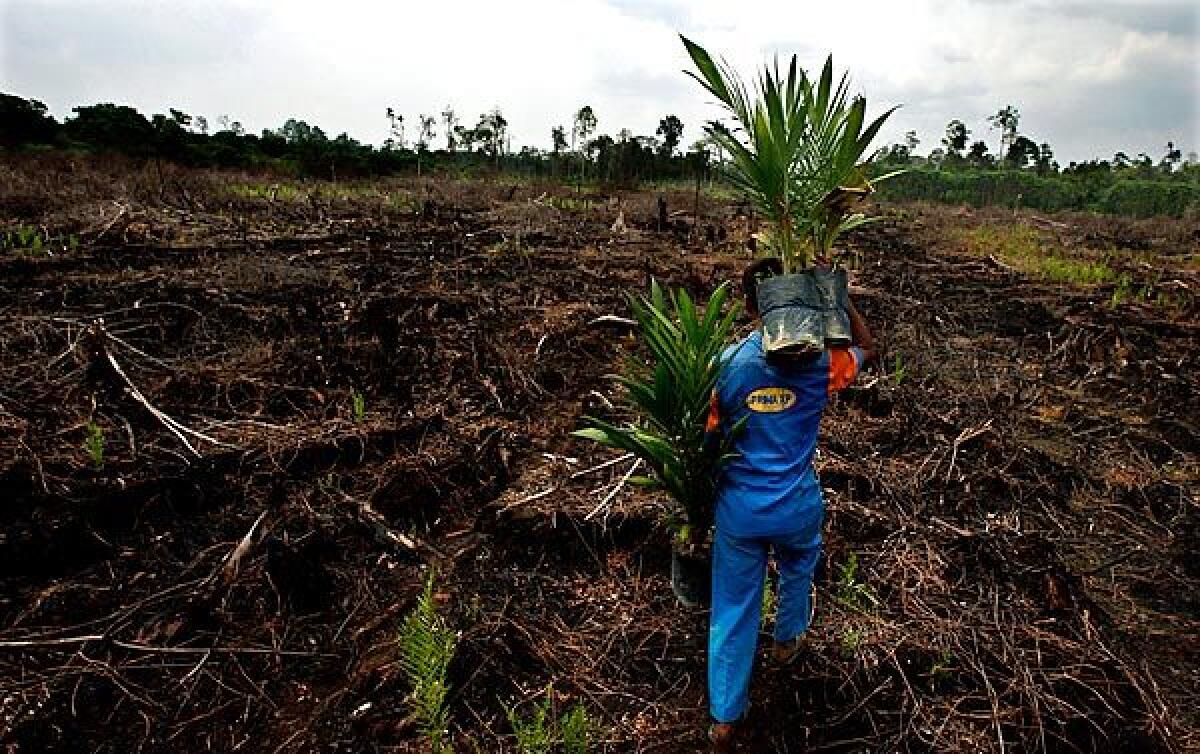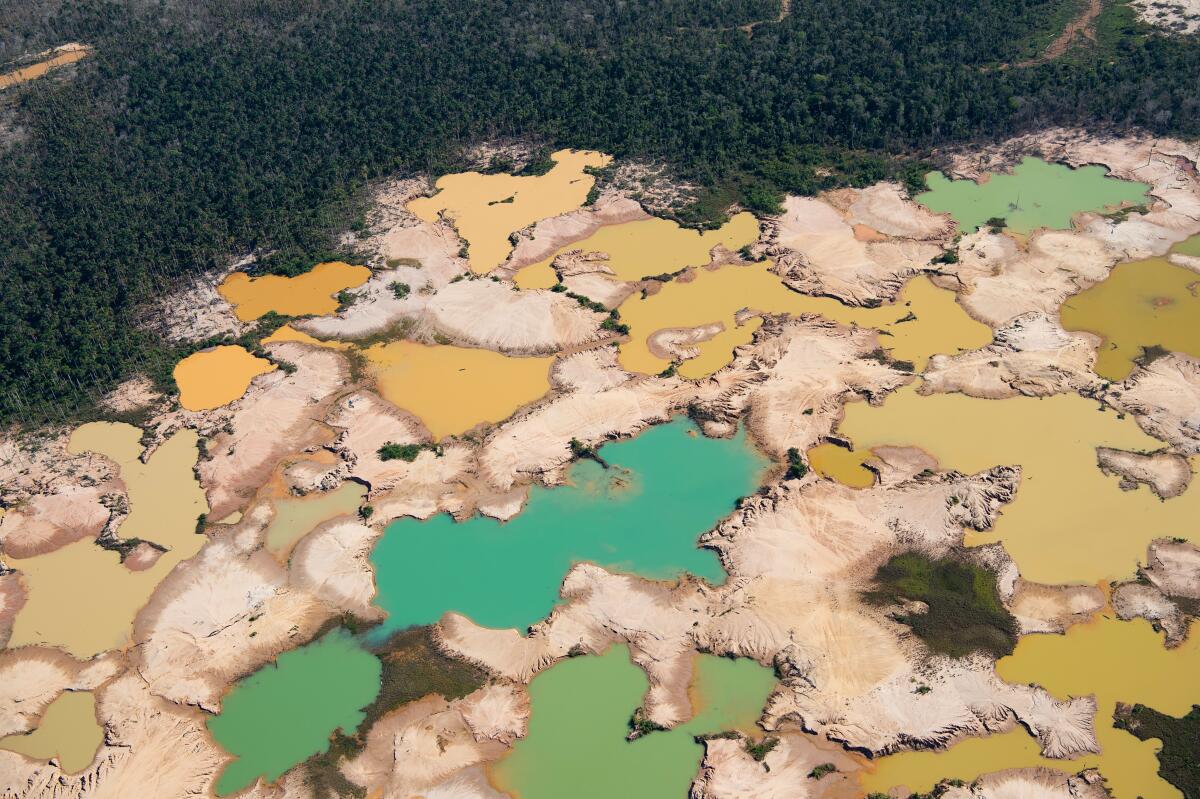They’ve managed the forest forever. It’s why they’re key to the climate change fight
- Share via
The first time Mandy Gull visited Canada’s Broadback Forest, she was struck by the displays of delicate lichen. By the dense, ancient trees. By the moss-covered floor, which rose and fell like a rumpled green blanket.
“There’s an energy in that kind of forest that I don’t think you find just anywhere,” said Gull, a member of the Cree First Nation of Waswanipi in Quebec and the deputy grand chief of the Cree Nation. “You have to go there and see it and feel it.”
For the record:
1:25 p.m. Nov. 5, 2019An earlier version of this article said Meares Island is off the coast of Victoria Island. It is off the coast of Vancouver Island.
Tucked into the south shore of Hudson Bay, the Broadback is home to old-growth spruce and three herds of endangered woodland caribou. It holds great significance for the Waswanipi Cree, which is why they are trying to save it from the clear-cutting that has already disturbed 90% of their traditional hunting grounds, including the trapline used by Gull’s family for generations.
“We’re so proud of our culture and so proud of our territory,” she said. “We have to fight for the things that are at risk.”
More than 600 indigenous communities live in Canada’s boreal forest, one of the last great swaths of intact wilderness on Earth. But every year, a million acres fall to logging to make timber and tissue products, including toilet paper sold in the U.S., according to the Natural Resources Defense Council. That’s seven hockey rinks’ worth of forest every minute.
Canada’s First Nations, with help from groups such as the NRDC and Greenpeace, want to stanch the losses and protect the lands their ancestors have depended upon for centuries — or longer.
Similar efforts around the globe will be critical to meeting the world’s climate goals, experts say.

Forests hold — and continually absorb — huge amounts of carbon, which would otherwise warm the planet in the form of carbon dioxide or methane. And a growing body of scientific evidence shows that indigenous peoples and other collective communities tend to do a better job of keeping forests and their carbon stores intact.
“Indigenous peoples generally have this worldview of relating in harmony with nature,” said Victoria Tauli-Corpuz, the United Nations special rapporteur on the rights of indigenous peoples, and a member of the Igorot people of the Philippines. “That’s the main source of their own survival as well as identities.”
More often than not, indigenous peoples use the land in ways that keep trees standing — for instance, by harvesting fruits and nuts rather than timber. Techniques such as controlled burning, smart grazing practices and paying close attention to natural processes have helped people steward their land over the ages.
As a result, communally managed lands hold about 300 billion tons of carbon — about half the amount humans have pumped into the atmosphere since the beginning of the Industrial Revolution.
Canada’s boreal forest and the soil beneath it contain about 12% of the world’s land-based carbon, said Jennifer Skene, an environmental law fellow at the NRDC.
“It’s our tremendous ally in the fight against climate change,” she said. “That carbon has to stay locked up there if we are going to avoid the worst impacts.”
But indigenous peoples and the forests they inhabit face increasing threats. In Canada, the danger comes from logging (although the government points out that the trees will eventually grow back) as well as fires and fossil fuel development. In Brazil, it’s a push for more cattle pasture. In Indonesia, it’s growing demand for palm oil.

In all, the planet is losing an area of forest the size of the United Kingdom every year, according to a recent assessment by a coalition of environmental groups. And new pressures arise all the time. Recent studies have found that drug cartels are driving new patterns of deforestation throughout Central America. They displace indigenous and rural people who live along their trafficking routes, and they fund destructive activities, such as clearing land for agriculture, to launder money.
Indigenous people often have limited options for warding off encroachment. Though communities use and manage almost half of the world’s land area, they have ownership over just a tenth of it, said Alain Frechette, a researcher at the nonprofit Rights and Resources Initiative.
Sometimes outsiders gain a toehold in subtle ways. For instance, they have married into communities and then taken control, said Anne Larson, who studies land rights at the Center for International Forestry Research.
Other times, land grabbers launch an all-out assault. In July, dozens of armed gold miners stormed a Waiãpi village in the Brazilian Amazon, killing an elder and forcing everyone else to flee.
The human rights group Global Witness estimated that, around the world, 164 indigenous activists and other environmental defenders were slain last year trying to protect their land.

In many cases, the threats to indigenous land are state-sanctioned. Governments frequently issue permits to companies to mine or log in indigenous territories. “They still see it as idle land that’s not being used that could be productive,” Larson said.
But research shows that granting indigenous groups formal rights to their lands is one of the most effective ways to support communities and conserve the forest.
For example, one study tracked what happened in the Peruvian Amazon after indigenous groups received official titles to their land. Using satellite imagery to estimate forest loss, researchers found that deforestation rates plummeted by 75% during the next two years. Another wide-ranging analysis showed that secure land rights were significantly correlated with forest preservation — or even gain — in Latin America and Africa.
Rights aren’t a silver bullet, but they do give people assurance that they can reap the benefits of sustainable forest management without having to turn to extractive industries for short-term profits, Larson said. In California, the Yurok tribe has made money from its forest preservation efforts by selling carbon credits through the state’s cap-and-trade program.
Rights also grant communities legal standing to rebuff intruders — as long as rights are respected and enforced by the government.
“The title is one thing, but knowing the title will be upheld … that piece has to also be there,” said Maggie Holland, a geographer at the University of Maryland, Baltimore County.
Over the last 15 years, the area formally owned by indigenous and local communities around the world has increased by half a million square miles, Frechette said. (That’s an area nearly twice the size of Texas.) He estimates that simply implementing existing laws in four countries — Indonesia, India, Colombia and the Democratic Republic of Congo — would more than double that.
The last few years have seen a groundswell of international support for indigenous rights, not only on humanitarian grounds but also for the good of the global environment. Over the summer, a high-profile report by the Intergovernmental Panel on Climate Change highlighted the need to empower indigenous peoples to meet international climate goals.

Even the pope recently advocated for protecting indigenous peoples in the Amazon and their forests, warning of “the greed of new forms of colonialism” and drawing fire from some quarters of the Catholic community that see indigenous cultures as pagan.
But Gull said she has yet to see global leaders truly embrace indigenous perspectives. She noted the lack of indigenous voices at the recent U.N. Climate Action Summit in New York, which she attended.
“If governments really want to make a serious change, they have to buckle down and they have to listen to what indigenous people are saying,” she said. “Stop saying it on their behalf and ask them what they think.”
Companies and consumers also need to consider the role of trade in driving deforestation and, by extension, climate change, Tauli-Corpuz said. After all, it’s the demand for products such as palm oil, beef and toilet paper that makes cutting down trees profitable in the first place.
“Many of the products that they consume come from forests where indigenous peoples’ rights are violated, and which are not sustainably managed and controlled,” she said.

Gull does see some signs of progress in Canada, where it was once illegal for indigenous people to sue the government over land claims.
Part of the Broadback is already safe from logging, and the Cree are negotiating with the government of Quebec to turn most of the watershed into a conservation area that they would help manage.
“It’s a very good discussion going on, it’s very positive,” said Michel Ares, the assistant manager of the Waswanipi forestry department and a member of the Cree’s negotiation team.
By the end of next year, the Canadian federal government hopes to establish 27 such Indigenous Protected and Conserved Areas across the country as part of its effort to protect 17% of its landmass under the U.N. Convention on Biodiversity.
Eli Enns, a political scientist and president of a nonprofit conservation group in British Columbia called the Iisaak Olam Foundation, said indigenous peoples can use these areas to do more than simply save a slice of nature. They can provide a glimpse of how humans can live more lightly on the land.
“Today, the tribal park is an olive branch to the dominant industrial violator,” said Enns, a member of the Tla-o-qui-aht First Nation. “We can do things differently here.”
Enns points to Meares Island off the coast of Vancouver Island. Thirty-five years ago, his forebears blocked logging crews from entering to harvest old-growth spruce trees and declared the entire island a park.
Now it supports numerous indigenous communities that rely on renewable hydropower and geothermal energy. It also provides water and natural attractions for the nearby tourist destination of Tofino.
“We can create a positive alternative,” Enns said. “Maybe no one is going to become a billionaire out of this, but everyone is going to get their needs met. And we can live and have abundance and just enjoy the beauty of the world.”







